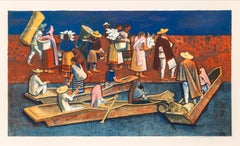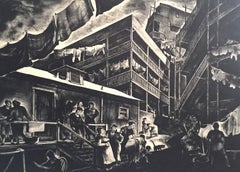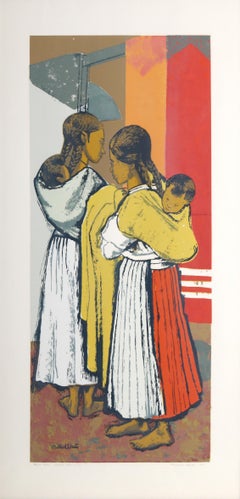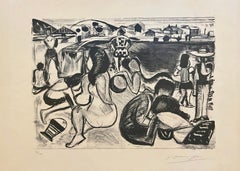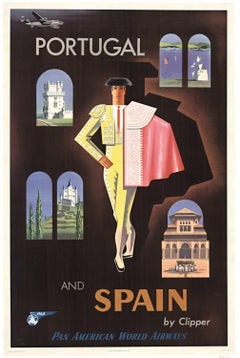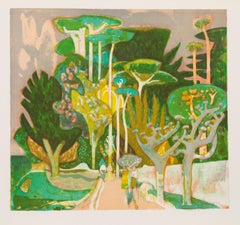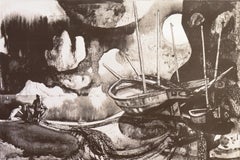Millard Sheets Figurative Prints
to
1
1
1
Overall Width
to
Overall Height
to
2
13
847
382
381
308
3
1
1
2
1
3
2
1
1
1
1
1
3
3
Artist: Millard Sheets
Mexican Travelers, Modern Lithograph by Millard Sheets
By Millard Sheets
Located in Long Island City, NY
Mexican Travelers by Millard Owen Sheets, American (1907–1989)
Date: Circa 1977
Lithograph on Arches paper, signed and numbered in pencil
Edition o...
Category
1970s American Modern Millard Sheets Figurative Prints
Materials
Lithograph
Millard Sheets, Family Flats, 1935 (Los Angeles, CA, Depression-era tenements
By Millard Sheets
Located in New York, NY
Signed, titled, and numbered, in pencil. The proposed edition was 100 although it is very unlikely that these were printed.
This large and intensely urban lithograph, Family Flats, by Millard Sheets, portrays the Bunker Hill neighborhood of Los Angeles. Now drastically changed, it's still home to the Angels Flight funicular railway built in 1901.
Sheets (1907-1989) was a painter, watercolorist, printmaker, mosaic artist, and teacher, who worked in Southern California. He attended the Chouinard Art institute and studied with F. Tolles Chamberlin and Clarence Hinkle...
Category
Mid-20th Century Ashcan School Millard Sheets Figurative Prints
Materials
Lithograph
Mexican Babysitter, Folk Art Screenprint by Millard Sheets 1949
By Millard Sheets
Located in Long Island City, NY
Mexican Babysitter
Millard Owen Sheets, American (1907–1989)
Screenprint, signed and numbered in pencil
Edition of AP
Image Size: 24 x 11 inches
Category
1940s American Modern Millard Sheets Figurative Prints
Materials
Lithograph
Related Items
Untitled abstract seaside, original lithograph
By François Desnoyer
Located in Belgrade, MT
Pencil signed black and white lithograph original limited edition pencil signed , Guilde De La Gravure. Mid 20th Century, part of my private collection. Very Good condition.
Category
Mid-20th Century Cubist Millard Sheets Figurative Prints
Materials
Lithograph
$636 Sale Price
33% Off
H 13 in W 15 in
Original Pan American World Airways by Clipper to Portugal and Spain poster
By Jean Carlu
Located in Spokane, WA
Original vintage poster: Portugal and Spain by Pan American World Airways Clipper, Artist: Jean Carlu. Pan American original vintage poster large travel size format 27.5" x 41.1" Earliest version (the 1950s) of the poster for travel by Constellation aircraft.
Original linen-backed, Pan American World Airways by Clipper vintage poster for travel to Portugal and Spain. Wear and stress marks in the top and bottom dark area but are not tears.. Small touch-up on the left white border.
In the middle of this image, it features a matador with a cape hanging off his shoulder. Surrounding the image in vignettes of cut-out windows showing typical landscape scenes and castles. A great smaller format original for "The World's Most Experienced Airline". One of the windmills shown in this image has cloth sails. Trimming the sails allowed the windmill to turn at near the optimal speed in a large range of wind velocities. Pan American World Airways by Clipper.
Pan American a.k.a. Pan Am Airlines posters are very collectible and rare year to year. This a great design opportunity for a home with a European flair. The Pan Am Clipper...
Category
1950s American Modern Millard Sheets Figurative Prints
Materials
Lithograph
$1,598
H 42 in W 27.5 in D 0.05 in
Original California Ferrari Louis Vuitton Parc de Bagatelle hand signed poster
By Razzia (Gérard Courbouleix–Dénériaz)
Located in Spokane, WA
Original 1989 Louis Vuitton Automobile Classiques Poster –Hand Signed, Archival Linen-Backed. This poster was created for the Concours d’Elegance ...
Category
1980s American Modern Millard Sheets Figurative Prints
Materials
Lithograph
Clemente Untitled B: surreal mythical landscape, voyage with ocean, Venus, snake
By Francesco Clemente
Located in New York, NY
A black and white, large-scale surreal mythical landscape of an ocean voyage, with a snake wrapped around a clock, a ship, Venus sculpture, greek urns, and snakes, printed in black o...
Category
1980s Contemporary Millard Sheets Figurative Prints
Materials
Lithograph
$2,975
H 26.75 in W 119.25 in
“Thebes, Great Hall at Karnak”
By David Roberts
Located in San Francisco, CA
This lithograph titled "Thebes, Great Hall at Karnak" is a notable work by the Scottish painter David Roberts (1796-1864). This particular scene is part of Roberts' most famous colle...
Category
1840s English School Millard Sheets Figurative Prints
Materials
Paper, Lithograph
Vintage David Hockney Poster Miami New World Festival of Arts 1982 palm trees
By David Hockney
Located in New York, NY
This vintage David Hockney poster features whimsical imagery and rich, bright color. Palm trees, boats in the ocean, a cafe, and a bodega with an elaborate iron-wrought balcony sit a...
Category
1980s Realist Millard Sheets Figurative Prints
Materials
Lithograph
Prodigal Son
By Thomas Hart Benton
Located in London, GB
A man raises his hand to his chin, his neck tilted and face turned to look at a dilapidated farmhouse, barely held together by planks of wood and exposed to the elements. Behind him ...
Category
1930s American Modern Millard Sheets Figurative Prints
Materials
Lithograph
“Winter” from the “Four Seasons Suite” Series
By Alvar Sunol Munoz-Ramos
Located in San Francisco, CA
This embossed, numbered and signed lithograph, part of the “Four Seasons Suite,” is by Alvar Suñol Muñoz-Ramos (b. 1935), a renowned Spanish ar...
Category
1970s Modern Millard Sheets Figurative Prints
Materials
Paper, Lithograph
$1,350
H 37.25 in W 30.5 in D 2 in
Down the River
By Thomas Hart Benton
Located in London, GB
In this sentimental work from 1939, Benton expresses his admiration for the rural lifestyle of the Midwest. He highlights the connection between man and the land by depicting two fig...
Category
1930s American Modern Millard Sheets Figurative Prints
Materials
Lithograph
Discussion
By Thomas Hart Benton
Located in London, GB
In this charming regionalist lithograph, Benton captures a classic Midwestern American scene: two men talking, drinking, and smoking together in a bar. Titled 'Discussion', the artwo...
Category
1930s American Modern Millard Sheets Figurative Prints
Materials
Lithograph
Nature Morte Harvest scene
By Maurice Savin
Located in Belgrade, MT
This lithograph is part of my private collection. It is original and pencil signed an numbered by the artist.
It is one of a kind in black and white.
Category
Mid-20th Century Abstract Expressionist Millard Sheets Figurative Prints
Materials
Engraving, Lithograph
"Labor in a Diesel Plant" Machine Age American Scene Industrial Mid 20th Century
By Letterio Calapai
Located in New York, NY
"Labor in a Diesel Plant" Machine Age American Scene Industrial Mid 20th Century
Letterio Calapai (American 1902-1993)
''Labor in A Diesel Plant''
Wood engraving, 1940
17 x 10 1/2...
Category
1940s American Modern Millard Sheets Figurative Prints
Materials
Lithograph
$6,900
H 23 in W 16 in D 2 in
Previously Available Items
Old Village, Modern Lithograph by Millard Sheets
By Millard Sheets
Located in Long Island City, NY
Old Village by Millard Owen Sheets, American (1907–1989)
Circa 1977
Lithograph on Arches, signed and numbered in pencil
Edition of 250, AP
Image Si...
Category
1970s American Modern Millard Sheets Figurative Prints
Materials
Lithograph
'The Islands', LACMA, Whitney Museum, Mid-century tonalist stone lithograph
By Millard Sheets
Located in Santa Cruz, CA
Signed lower right, 'Millard Sheets' (American, 1907-1989) and dated 1972; additionally titled lower left 'The Islands' and with number and limitation '126/200'.
Blind stamp to lower left from William Kessler Company.
Born in Pomona, California, Millard Sheets grew up on a ranch where he developed his abiding love of the land and of horses. Sheets attended the Los Angeles School of Art as the pupil of F.T. Chamberlain and Clarence Hinkle...
Category
1970s American Modern Millard Sheets Figurative Prints
Materials
Paper, Lithograph
FAMILY FLATS
By Millard Sheets
Located in Portland, ME
Sheets, Millard. FAMILY FLATS. Lithograph, 1934. Edition of about 75. Titled and signed in pencil. 15 3/4 x 21 3/4 inches (image). Framed to 25 x 32 inches. In excellent condition.
Category
1930s Millard Sheets Figurative Prints
Materials
Lithograph
Millard Sheets figurative prints for sale on 1stDibs.
Find a wide variety of authentic Millard Sheets figurative prints available for sale on 1stDibs. You can also browse by medium to find art by Millard Sheets in lithograph and more. Much of the original work by this artist or collective was created during the 20th century and is mostly associated with the modern style. Not every interior allows for large Millard Sheets figurative prints, so small editions measuring 15 inches across are available. Customers who are interested in this artist might also find the work of John French Sloan, Clifford Isaac Addams, and Bernard Brussel-Smith. Millard Sheets figurative prints prices can differ depending upon medium, time period and other attributes. On 1stDibs, the price for these items starts at $950 and tops out at $13,500, while the average work can sell for $1,350.
